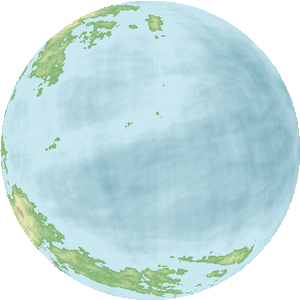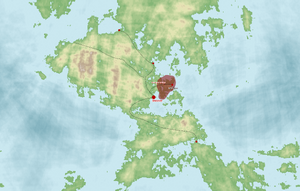Gulion
Gulion is a planet located within known space and serves as the capital world of the Gulion System. It is known for its extreme climate, dense atmosphere, and some strategic importance within human-colonized space.
| Planet | Gulion |
| System | Gulion System |
| Capital | Bhoover |
| Atmosphere | Thick, storm-prone |
| Temperature | Hot equator, fluctuating seasons |
| Population | 1.8 billion, concentrated in urban centers |
| Economy | Trade, industry, military presence |
| Status | Colonized, strategically significant |


Physical Characteristics
Gulion possesses a thick atmosphere, making it challenging for non-adapted species and requiring specialized infrastructure for habitation. - The planet experiences frequent and severe storms, especially in equatorial regions. - Surface temperatures vary, but equatorial regions can exceed 40°C during peak seasons. - Despite its harsh conditions, it has been extensively colonized due to its strategic location.
Colonization and Development
Originally colonized during humanity’s early interstellar expansion, Gulion has become a major hub for trade and industry. The planet's capital, Bhoover, is located at the equator, serving as both a population center and a launch site for space travel. - Bhoover houses one-third of the planetary population. - The planet is vital for logistics, trade, and manufacturing in human space.
Notable Locations
Bhoover
The capital city, Bhoover, is a bustling metropolis that serves as the economic and political heart of the planet. - Major spaceports and corporate headquarters are located here. - The city is heavily urbanized and requires advanced atmospheric management systems. - Extreme weather patterns occasionally disrupt daily life but have led to the development of highly resilient infrastructure.
Economy and Industry
Due to its location and importance, Gulion has a diverse economy: - Heavy Industry: Large-scale manufacturing and resource refinement. - Trade Hub: A key transit point for interstellar trade routes. - Military Presence: Several military facilities provide planetary and regional defense.
Climate and Environmental Challenges
Gulion’s dense atmosphere and frequent storms create both opportunities and challenges for its inhabitants. Advanced climate control technology is necessary to sustain long-term settlements, and structures are built to withstand high winds and temperature fluctuations.
Political and Strategic Importance
Gulion plays a crucial role in regional politics: - It serves as a key administrative center for the surrounding star systems. - The planet is home to corporate entities and independent factions, sometimes leading to power struggles over its vast resources. - Due to its strategic trade position, conflicts occasionally arise regarding control of its infrastructure.
| Property | Value | Earth Comparison |
|---|---|---|
| Planet Type | Terrestrial | Terrestrial |
| Atmosphere | Cool, Wet, Thick (N2, He, O2 - breathable) | - |
| Distance from Primary Star | 1.7 × 108 KM | 1.162 AU |
| Mass | 9.6 × 1024 Kg | 1.602 Earth masses |
| Surface Gravity | 1156.8 cm/sec2 | 1.18 Earth gees |
| Surface Pressure | 2600 millibars | 2.566 Earth atmospheres |
| Surface Temperature | 11.0° C / 51.8° F | -3.0° C / -5.4° F |
| Normal Temperature Range (Night) | 8.3° C / 47.0° F | - |
| Normal Temperature Range (Day) | 13.5° C / 56.3° F | - |
| Min Temperature | -10.2° C / 13.6° F | - |
| Max Temperature | 31.1° C / 88.0° F | - |
| Equatorial Radius | 7432.0 Km | 1.2 Earth radii |
| Density | 5.57 grams/cc | 1 Earth density |
| Eccentricity of Orbit | 0.249 | - |
| Escape Velocity | 13.1 Km/sec | - |
| Molecular Weight Retained | 3.4 and above (He, N, O, CH4, NH3, H2O, Ne, N2) | - |
| Atmospheric Composition | ||
| Nitrogen | 80.3% (2088 mb) | ipp: 2038 |
| Helium | 10.7% (277 mb) | ipp: 271 |
| Oxygen | 8.5% (221 mb) | ipp: 215 |
| Argon | 0.5% (13 mb) | ipp: 13 |
| Axial Tilt | 27° | - |
| Planetary Albedo | 0.27 | |
| Length of Year | 457.58 Earth days | 770.09 Local days (1.25 Earth years) |
| Length of Day | 24.26 hours | - |
| Boiling Point of Water | 128.2° C / 262.7° F | - |
| Hydrosphere Percentage | 83.8% | - |
| Cloud Cover Percentage | 47.6% | - |
| Ice Cover Percentage | 2.9% | - |